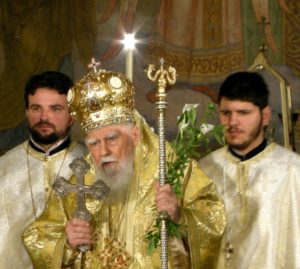Beginning in the post-Communist era in the early 1990s, a faction of schismatics emerged in Bulgaria, breaking away from the canonical Bulgarian Orthodox Church. These schismatics — known as the “Alternative Synod” — elected their own Patriarch in 1996, with the backing of the Bulgarian government. Under immense pressure, the canonical Bulgarian Church appealed to its sister Orthodox Churches for help.
On June 29, 1998, the Patriarch of Alexandria, Petros VII, visited Bulgaria, and, in a show of support for the canonical Bulgarian Church, he concelebrated the Divine Liturgy in with the Bulgarian Patriarch Maxim. The Alexandrian Patriarch then gave speech at the seminary in Sofia, openly criticizing the Bulgarian government for meddling in church affairs.
What happened next was kind of amazing. On September 17, envoys from Constantinople arrived to explore the possibility of holding a Pan-Orthodox Council. Within thirteen days of their arrival (!), the Council began.
Think about that for a moment. Faced with a crisis, the Ecumenical Patriarchate managed to pull together a Pan-Orthodox Council in less than two weeks.
The Council took place in Sofia, Bulgaria over two days — September 30 and October 1. It was chaired, of course, by Ecumenical Patriarch Bartholomew. Its attendance list included the primates (or their representatives) from 13 of the 14 universally-recognized autocephalous Churches (only Georgia was absent). It also included some 22 additional bishops, for a total of 35.
Patriarch Maxim of Bulgaria made his case, and then a top Bulgarian governmental official kind of burst in and made a scene, which only served to convince the assembled Orthodox hierarchs that the Patriarch was correct, and that the government was improperly intervening in Church matters. Here is how one account describes the rest of the Council:
Eventually, after torturous negotiations, the schismatic leaders removed their insignia, proffered their public repentance and expressed their desire to return to the Orthodox Church and specifically to the canonical Church of Bulgaria under Patriarch Maksim’s leadership. Only Pimen [the Patriarch of the Alternative Synod] was not present, ostensibly for health reasons.
In view of their past intrasigence, the Council showed remarkable magnanimity as it applied the Orthodox doctrine of exceptional economy in forgiving all participants, clerical and lay. It even reinstated Kalinik to his see at Vrasta, but split it in two, creating a new diocese centered in Pleven under Metropolitan Ignati.
It accepted statements of repentance from Pimen and twelve bishops, including some consecrated by the schismatics, and gave them titles of ancient sees. It annulled the anathema against Pimen and his demotion to monastic status, but in view of his age — he was 93 — did not reinstate him, though it allowed him the title ‘former metropolitan of Nevrokop,’ leaving his replacement, Natanail, as metropolitan.
The Council emphasized the duty of the rehabilitated clergy and laity humbly to accept Maksim and his bishops as their canonical pastors, in communion with local Orthodox churches. It concluded that the schism was at an end. Bartholomaios [i.e., Ecumenical Patriarch Bartholomew] emphasized that neither side could claim victory or defeat; only the Devil had lost. The primates reaffirmed that schisms within local churches constitute a grievous sin which prevents the faithful from receiving the sanctifying and saving grace of the Holy Spirit. It arrived at its decisions unanimously.
All of that comes from Janice Broun’s indispensible paper, “The Schism in the Bulgarian Orthodox Church, Part 3: Under the Second Union of Democratic Forces Government, 1997-2001,” Religion, State & Society, Vol. 30, No. 4 (2002). (Publicly-available information about this Council is hard to find on the Internet, because it was 20 years ago and the Internet was a different thing back then. But one contemporary source you can read is the Moscow Patriarchate’s official statement on the Council, from October 5, 1998. Click here to read it.)
I just quoted a big block of text, but if you skipped ahead, please go back and read it. This is the best description I’ve yet found of a really remarkable event in modern Church history.
Unfortunately, the irenic 1998 Pan-Orthodox Council did not end, once and for all, the Bulgarian schism. Despite its seemingly ideal outcome, the schism ultimately reestablished itself, and it lasted until 2015, when it was finally healed — by all accounts, with Ecumenical Patriarch Bartholomew playing an essential role as mediator.
Although the Council itself didn’t exactly achieve its goal of ending the schism, its composition and actions are really quite remarkable. As best I can tell, this is the most well-represented Council in the history of the Church, in terms of the number of Churches that participated (at least, until 2005). The Council acted with decisive authority, reinstating schismatics, annulling depositions, and even reorganizing a diocese. And all this, with unanimous votes every time. (And it shouldn’t be forgotten that all this took place less than two years after the Estonia crisis that caused a temporary break in communion between Constantinople and Moscow.)
The Pan-Orthodox Council of Sofia in 1998 is a landmark moment in Church history that should not be forgotten, but, rather, looked to as a model.
